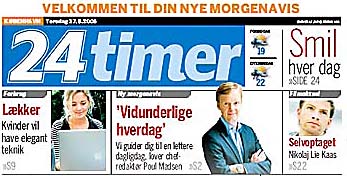
| Fit To Print |
 |
followthemedia.com - a knowledge base for media professionals |
|
|
ftm newsletter
ftm newsletter updates leading media news each Monday and Thursday. AGENDA
|
||
“Bloodbath” Is The One Word That Pops Up More Than Any Other When Discussing The Danish Free Newspaper War; All The Players Are Very Rich, But They Are Giving A Whole New Definition To The Term “Deep Pockets”Just the thought by Danish newspaper publishers that Iceland’s largest media conglomerate was launching a free newspaper in September, delivered by the post office to homes before 7 am, caused such panic that they responded by launching four free newspapers within the past couple of weeks and the morning Metro has started a PM edition. No doubt contemplating how to read all those free newspapers Talk about survival of the fittest – the financial accounts of these traditional media companies are going to be covered in red for some time to come with advertising rates hitting rock bottom. But the thinking must be, better to be covered in red and fight it out than march meekly to the abattoir. The Danish publishers believe they have good reason to worry based on what they have seen in Nordic neighbor Iceland. It didn’t take too long after 365 Media Scandinavia launched its Fréttablaðið newspaper in Iceland directly to homes that it became the country’s top read newspaper and it now boasts of a readership of 68.3%. That helped put Iceland today at the head of the global table of free newspaper readership per 100 inhabitants. So when 365 Media Scandinavia announced a few months back it had struck a joint venture with the Danish Post Office to deliver, starting in September, a new Danish free newspaper, Nyhedsavisen, to Danish households by 7 a.m, the Danish publishers knew they had to fight back for survival.
Their preferred method – launching their own free newspapers before Nyhedsavisen gained a toe-hold. Now none of this comes cheaply, as the interloper 365 Media Scandinavia admits, and its corporate owners have now decided that even Iceland’s largest media corporation cannot afford such a Danish adventure alone. It is part of the Dagsbrun Communications conglomerate that recently released first half financials boasting record sales of 20.18 billion Icelandic krona (€224 million) – 188% higher than the same period last year – but combined with a loss of 1.522 billion Icelandic krona (€16.9 million). The company has been busy gobbling up various businesses over the past couple of years and it now has a severe case of financial indigestion. Obviously it needs to get its cost structure under control, and with that in mind it has taken a second look at its Danish plans. Rather than go it alone in launching Nyhedsavisen, it is setting up an investment vehicle to fund it and possibly other free newspapers in other markets. Dagsbrun says it will manage the fund, seed it with 600 million Icelandic krona (€6.7 million) that would leave it as a minority shareholder, and that it is looking for national and international investors. Some in Denmark now question whether Nyhedsavisen will even get off the ground, and if it does whether it can make its planned September launch, but Dagsbrun’s CEO, Gunnar Eglisson, says there is enough funding already to run the newspaper for three to five years. The Danes say that €6.7 million (50 million Danish kroner) is a spit in the ocean to what it will really cost Dagsbrun if it enters the Danish market. “You need to use much, much more,” said Lars Munch, head of operations at the country’s largest newspaper publishing house, JP/Politiken. He has a point. Agora in Poland – where costs are far less than in Denmark – closed down its paid-for Nowy Dzien in February after just three months and that launch/closure cost €5.7 million. To beat Nyhedsavisen’s launch the traditional media publishers knew they could not take the usual time to launch their free counterattacks. Whereas London’s Associated Newspapers says its September launch of London Lite was three years in the making, the Danes knew they had at best a few weeks to start from scratch, getting their free newspapers on the street and also delivered directly to homes. And somewhat amazingly, they met their deadline. Ally Palmer, a partner in the Scottish design house, Palmer Watson, was involved in designing JP/Politiken’s free 24timer launched last week. “We were involved from the early stages with 24timer, working on the concept with executives as well as on design. Towards the end of June there were a couple of editors, an empty office, and a few scribbled sketches. No staff, no desks, no computers, no name. A month and a half later 24timer hit the street.” And fast as that was, Dato, published by Berlingske Tidende, owned by Norway’s Orkla Media, in turn owned by Britain’s David Montgomery, apparently hit the street about a week after executives were told to set up and launch a free newspaper. It seconded about 35 staff from Berlingske, and aims for a total circulation of around 500,000, including being delivered to all homes in Copenhagen and Aarhus. Palmer, who had the lead role in the redesign of Le Monde, has had experience in Denmark before, helping Ekstra Bladet, the JP/Politiken Copenhagen PM, launch Flash!, a Sunday celebrity news supplement that has done very well, so he knows the market pretty well. He points out that in addition to the appearance of free newspapers the traditional media are also getting new looks. 
“We are working with Politiken, Denmark’s highly respected broadsheet, in what promises to be an extremely interesting relaunch. Its rivals are changing, too, Berlingske Tidende is going tabloid; Jyllands-Posten has just redesigned.
It will be fascinating to see how the country’s newspaper market looks at the end of the year,” he said. It will, indeed.
|
| copyright ©2004-2006 ftm publishing, unless otherwise noted | Contact Us • Sponsor ftm |